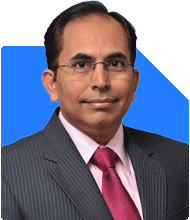Ramalingam Kalirajan |10876 Answers |Ask -Follow
Mutual Funds, Financial Planning Expert - Answered on May 16, 2024
He has an MBA in finance from the University of Madras and is a certified financial planner.
He is the director and chief financial planner at Holistic Investment, a Chennai-based firm that offers financial planning and wealth management advice.... more

Hi, I have 1cr corpus 2 lakhs in my ppf, 1lakh in MF, 6 lakhs in stocks. Earning 1.3 lakhs pm. Can i retire by investing rightly please advise ? I need 1 lakh a month for expenses.
Understanding Your Assets
Corpus Allocation: Your corpus of 1 crore is a valuable asset that can potentially generate passive income to support your retirement.
PPF and MF Investments: Your investments in PPF and mutual funds provide a mix of stability and growth potential, contributing to your overall financial portfolio.
Stock Investments: Holding 6 lakhs in stocks offers the opportunity for capital appreciation and dividend income, albeit with some level of risk.
Evaluating Retirement Readiness
Monthly Income: With an earning of 1.3 lakhs per month, you have a substantial income stream that can contribute to your retirement savings.
Expense Requirements: Your monthly expense target of 1 lakh is crucial in determining how much you'll need from your investments to sustain your retirement lifestyle.
Retirement Investment Strategy
Income Generation: Focus on building a diversified investment portfolio that generates regular income to cover your monthly expenses.
Asset Allocation: Consider reallocating your assets to achieve a balanced mix of income-generating investments such as fixed deposits, dividend-paying stocks, and bonds.
Risk Management: Assess and manage the risk associated with your investments to ensure steady income streams during retirement.
Retirement Income Sources
Passive Income: Explore avenues to generate passive income from your investments, including rental income from real estate, dividends from stocks, and interest from fixed deposits.
Annuity Plans: Annuity plans can provide guaranteed income during retirement, offering stability and peace of mind.
Financial Planning Recommendations
Comprehensive Retirement Plan: Consult with a Certified Financial Planner (CFP) to develop a personalized retirement plan tailored to your financial goals and risk tolerance.
Regular Reviews: Periodically review and adjust your retirement plan based on changes in your financial situation, market conditions, and retirement goals.
Emergency Fund: Maintain an emergency fund to cover unexpected expenses and contingencies during retirement.
Conclusion
While your current investments provide a solid foundation for retirement, it's essential to develop a comprehensive retirement plan that addresses your income needs, risk tolerance, and long-term financial goals. By investing wisely and seeking professional guidance, you can work towards achieving a financially secure and fulfilling retirement.
Best Regards,
K. Ramalingam, MBA, CFP,
Chief Financial Planner,
www.holisticinvestment.in
You may like to see similar questions and answers below
Ramalingam Kalirajan |10876 Answers |Ask -Follow
Mutual Funds, Financial Planning Expert - Answered on Aug 13, 2024
Ramalingam Kalirajan |10876 Answers |Ask -Follow
Mutual Funds, Financial Planning Expert - Answered on Jan 21, 2025
Janak Patel |71 Answers |Ask -Follow
MF, PF Expert - Answered on Jan 29, 2025
Ramalingam Kalirajan |10876 Answers |Ask -Follow
Mutual Funds, Financial Planning Expert - Answered on Dec 09, 2025
Ramalingam Kalirajan |10876 Answers |Ask -Follow
Mutual Funds, Financial Planning Expert - Answered on Dec 09, 2025
Radheshyam Zanwar |6739 Answers |Ask -Follow
MHT-CET, IIT-JEE, NEET-UG Expert - Answered on Dec 09, 2025
Radheshyam Zanwar |6739 Answers |Ask -Follow
MHT-CET, IIT-JEE, NEET-UG Expert - Answered on Dec 09, 2025
Nayagam P P |10853 Answers |Ask -Follow
Career Counsellor - Answered on Dec 09, 2025
Mayank Chandel |2569 Answers |Ask -Follow
IIT-JEE, NEET-UG, SAT, CLAT, CA, CS Exam Expert - Answered on Dec 08, 2025
Mayank Chandel |2569 Answers |Ask -Follow
IIT-JEE, NEET-UG, SAT, CLAT, CA, CS Exam Expert - Answered on Dec 08, 2025

Mayank Chandel |2569 Answers |Ask -Follow
IIT-JEE, NEET-UG, SAT, CLAT, CA, CS Exam Expert - Answered on Dec 08, 2025
Mayank Chandel |2569 Answers |Ask -Follow
IIT-JEE, NEET-UG, SAT, CLAT, CA, CS Exam Expert - Answered on Dec 08, 2025
Mayank Chandel |2569 Answers |Ask -Follow
IIT-JEE, NEET-UG, SAT, CLAT, CA, CS Exam Expert - Answered on Dec 08, 2025






















